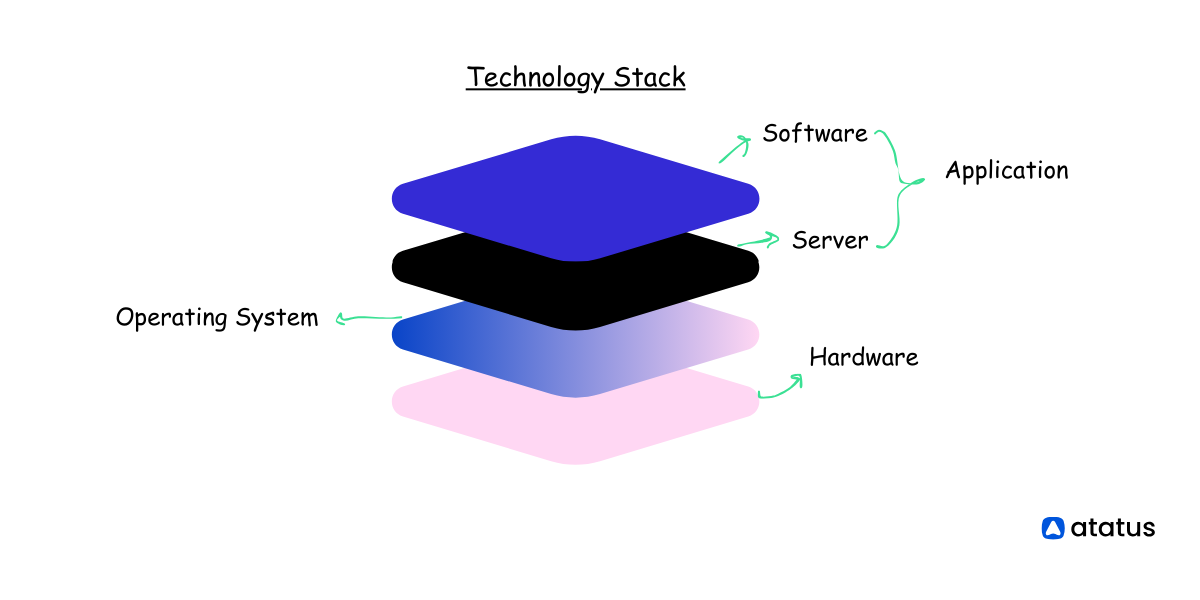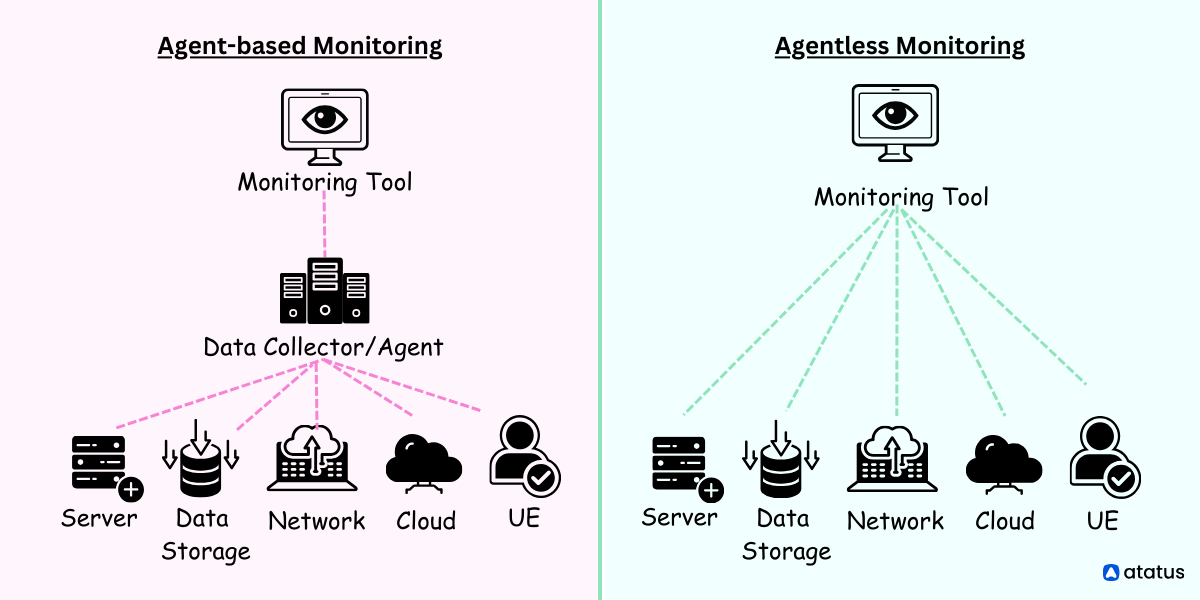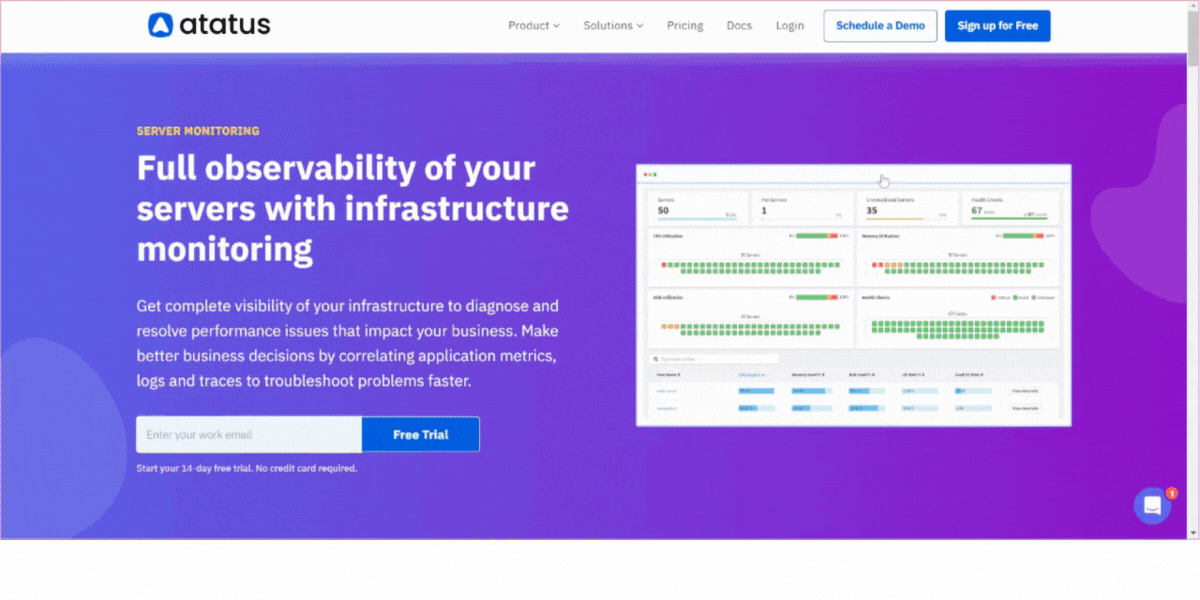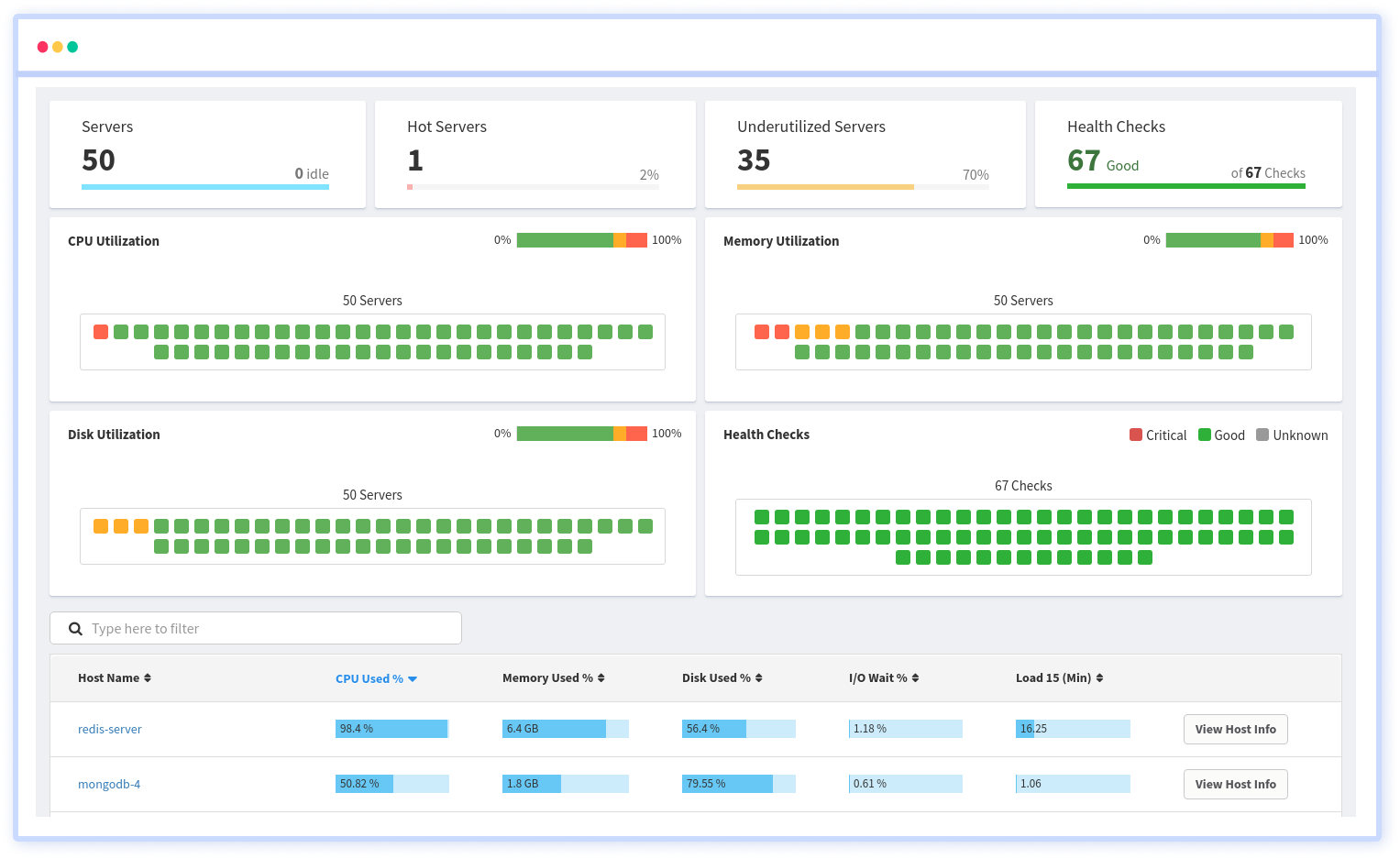Part 1: What is Infrastructure Monitoring?
The term "Infrastructure" encompasses various components, including hardware, software, networks, servers, databases, and more. Collectively, these components form the foundation for an organization's digital services and operations.
However, the intricate nature of these systems also introduces challenges related to performance bottlenecks, potential faults, security vulnerabilities, and the ever-present need for scalability.
Infrastructure monitoring acts as the sentinel, continuously gathering, analyzing, and interpreting data from various elements within the IT infrastructure. By monitoring crucial metrics such as CPU usage, memory allocation, network latency, and application performance, organizations gain valuable insights into the health and efficiency of their systems.
Beyond mere performance metrics, infrastructure monitoring encompasses availability checks, security audits, and proactive fault detection to ensure a resilient and secure digital infrastructure.
Knowing a bit about Infra in itself is fundamental to navigating this digital terrain, offering a comprehensive understanding of the tools and techniques essential for ensuring seamless operation (about which we will talk in the following article), optimal performance, and security of an organization's technological backbone.
In this part, we will be looking at the basics of infrastructure monitoring, why you must adopt it, and what challenges you might face down the road if you don’t. There is a lot of other details as well. So, without stalling, let’s get right into it!
Table Of Contents:
- What is Infrastructure Monitoring?
- Kinds of Infrastructure Monitoring
- How Infrastructure Monitoring Works?
- How does Infrastructure Monitoring help?
- Where to implement Infrastructure Monitoring?
- Infrastructure Monitoring Challenges
- Tools and Metrics
What is Infrastructure Monitoring?
Infrastructure monitoring is a systematic approach to overseeing and managing the diverse components of an organization's IT infrastructure. This process involves using specialized tools and software to collect, analyze, and visualize data from various sources such as servers, networks, databases, and applications.
The primary objective is to ensure the entire technological ecosystem's continuous health, performance, and security. By constantly monitoring key metrics and performance indicators, infrastructure monitoring enables IT professionals to detect issues in real time, anticipate potential bottlenecks, and proactively address deviations from optimal functioning.
Through generating alerts, dashboards, and comprehensive reports, infrastructure monitoring provides valuable insights that empower organizations to optimize resource utilization, enhance system reliability, and respond promptly to evolving challenges in the dynamic landscape of information technology.

Kinds of Infrastructure Monitoring
Infrastructure monitoring can be broadly categorized into two main types: agent-based and agentless. These approaches differ in how they collect and transmit data from the monitored components of an IT infrastructure.
1. Agent-Based Monitoring
In agent-based monitoring, small software components known as agents are installed on each device or server that requires monitoring. These agents collect data locally and transmit it to a central monitoring server.
Pros:
- Granular Data Collection - Agents can collect detailed and specific information from the host system, providing a granular view of its performance.
- Efficient Communication - Agents often use optimized communication protocols, reducing network overhead and enhancing efficiency.
- Offline Monitoring - Agents can continue collecting and storing data even if the monitored device temporarily loses connectivity to the central monitoring system.
Cons:
- Agent Deployment - Installing and maintaining agents on every monitored device can be resource-intensive and may require additional administrative effort.
- Resource Consumption - The agents themselves consume system resources (CPU, memory), although modern agents are designed to be lightweight.
2. Agentless Monitoring
Agentless monitoring, as the name suggests, doesn't require the installation of dedicated software agents on each monitored device. Instead, it relies on existing protocols and interfaces to collect data remotely.
Pros:
- Simplified Deployment - Since no agents need to be deployed, the initial setup is often simpler and faster.
- Reduced Overhead - The monitored devices do not consume additional resources, making them suitable for environments where resource usage must be minimized.
- Ease of Maintenance - Maintenance tasks are typically less complex without agents to manage.
Cons:
- Limited Data Collection - Agentless monitoring might have limitations regarding the granularity and depth of data it can collect compared to agent-based solutions.
- Dependency on Protocols - This relies on existing protocols (e.g., SNMP, WMI) and may be constrained by the capabilities of those protocols.
- Real-Time Challenges - Some real-time monitoring tasks may be more challenging without a dedicated agent running on the monitored device.

Some environments may benefit from combining both approaches, using agent-based monitoring for critical systems that require detailed insights and agentless monitoring for less critical components where simplicity and reduced resource consumption are prioritized.
How Infrastructure Monitoring Works?
Here's an overview of how infrastructure monitoring typically works:
Infrastructure monitoring tools gather data from different sources within the IT environment. This data can include information about servers, network devices, databases, applications, and other infrastructure components. Commonly monitored metrics include CPU usage, memory usage, disk space, network latency, error rates, etc.
1. Agent-Based or Agentless Monitoring
As we saw in the above section, some monitoring tools use agents to collect and send data. In contrast, others use agentless monitoring, relying on protocols like SNMP (Simple Network Management Protocol) or APIs (Application Programming Interfaces) to gather information without installing additional software on monitored devices.
The collected data is processed and analyzed in real-time or near real time. This allows for immediate identification of potential issues or deviations from normal behavior. Real-time monitoring is crucial for proactive problem detection and quick response to emerging issues.
2. Alerting and Notification
When the monitoring system identifies abnormal conditions or breaches predefined thresholds, it triggers alerts or notifications. These alerts are sent to IT administrators or relevant stakeholders, informing them of the issue. Alerts can be configured for various severity levels, helping prioritize and address critical problems first.
3. Visualization and Dashboards
Infrastructure monitoring tools often provide dashboards and visualization features that present the collected data comprehensibly. Graphs, charts, and other visual representations make it easier for IT professionals to assess the health and performance of the infrastructure quickly.
Monitoring tools store historical data, allowing IT teams to analyze trends. This historical analysis is valuable for capacity planning, identifying patterns, and understanding how the infrastructure behaves under different conditions.
Advanced infrastructure monitoring systems may include automation capabilities for remediation. When certain issues are detected, predefined automated actions can be triggered to address the problem, such as restarting a service, reallocating resources, or executing scripts.
Integration with ITSM platforms enables a streamlined workflow for issue resolution. Monitoring tools can create tickets, assign tasks, and provide relevant information directly within the ITSM system.
Organizations can proactively manage and optimize their IT environments by implementing infrastructure monitoring, ensuring high performance, availability, and security while minimizing downtime and potential disruptions.
How does Infrastructure Monitoring help?
Infrastructure monitoring serves as a vigilant guardian, tirelessly overseeing the intricate web of IT components that form the backbone of organizational operations. Its value lies in its ability to offer a proactive, real-time lens into an organization's digital infrastructure's health, performance, and security.
By constantly collecting and analyzing data from servers, networks, applications, and other crucial components, infrastructure monitoring empowers IT teams to detect anomalies and potential issues before they cascade into disruptive problems. This proactive stance is akin to preventive medicine for an organization's technological ecosystem, mitigating risks and minimizing the impact of potential disruptions.
Moreover, infrastructure monitoring acts as a strategic ally in optimizing resource utilization. By analyzing historical trends and real-time metrics, organizations can identify patterns, plan for future capacity needs, and allocate resources efficiently. This enhances the overall performance of the IT infrastructure software and contributes to cost-effectiveness by avoiding unnecessary overprovisioning.
The immediacy of alerting mechanisms in infrastructure monitoring ensures that IT teams can swiftly respond to incidents, reducing downtime and maintaining service availability. Whether it's a spike in resource usage, a security breach, or a potential system failure, timely notifications enable proactive problem resolution, often before end-users are even aware of a potential issue.

Where to implement Infrastructure Monitoring?
We have looked at what is Infrastructure Monitoring throughout this blog, no we will look into places to implement it. Infrastructure monitoring should be implemented across various layers of an organization's IT environment to ensure comprehensive coverage. Here are key areas where infrastructure monitoring is commonly implemented:
i.) Servers and Hosts
- Monitor the health, performance, and resource utilization of servers.
- Track CPU usage, memory usage, disk space, and network activity.
- Identify potential issues that could impact server availability and performance.
ii.) Network Devices
- Monitor network infrastructure components such as routers, switches, and firewalls.
- Track network bandwidth, latency, and error rates.
- Identify and respond to network issues, ensuring optimal connectivity.
iii.) Databases
- Monitor database performance and query execution times.
- Track database server metrics, including CPU usage, memory utilization, and disk I/O.
- Identify and resolve potential bottlenecks in database operations.
iv.) Applications
- Monitor the availability and performance of applications.
- Track response times, error rates, and transaction success rates.
- Identify issues impacting application performance and user experience.
v.) Virtualized Environments
- Monitor virtual machines (VMs) and hypervisors.
- Track resource utilization within virtualized environments.
- Identify and address performance issues in virtualized infrastructure.
vi.) Storage Systems
- Monitor storage infrastructure, including SAN (Storage Area Network) and NAS (Network Attached Storage) devices.
- Track storage capacity, I/O performance, and latency.
- Identify and resolve storage-related issues.
vii.) Operating Systems
- Monitor the operating systems of servers, virtual machines, and other devices.
- Track system logs, updates, and security configurations.
- Identify and address issues related to the operating system.
viii.) Logs and Events
- Centralize and monitor logs and events generated by different components.
- Use log management tools to analyze logs for troubleshooting and security purposes.
- Identify patterns and anomalies in log data.
By implementing infrastructure monitoring across these diverse areas, organizations can gain a holistic view of their IT environment, proactively detect issues, and ensure their technology infrastructure's overall health, performance, and security.
Infrastructure Monitoring Challenges
Navigating the terrain of infrastructure monitoring comes with its challenges, reflective of the dynamic nature of IT ecosystems. Understanding and effectively addressing these hurdles is crucial for ensuring the reliability and efficiency of the monitoring process. Here are some challenges commonly encountered:
i.) Diverse Technology Stack
As organizations embrace diverse technologies and architectures, monitoring solutions must adapt to heterogeneous environments. Compatibility issues and the need for comprehensive support across various platforms can pose a significant challenge.
ii.) Scalability Concerns
Scaling infrastructure monitoring to accommodate growing and evolving IT environments can be intricate. Ensuring that monitoring tools seamlessly scale alongside expanding infrastructure without compromising performance is a constant challenge.
iii.) Data Overload
The sheer volume of data generated by different components of an IT ecosystem can be overwhelming. Sorting through the vast amounts of information to identify actionable insights without drowning in a sea of data becomes a balancing act.
iv.) False Positives and Negatives
It is challenging to strike the right balance between sensitivity and specificity in alerting. False positives (unnecessary alerts for non-issues) can lead to alert fatigue, while false negatives (missed alerts for actual problems) may delay responses to critical issues.
v.) Complex Configurations
Configuring and maintaining monitoring tools to align with an organization's specific needs can be complex. Ensuring accurate threshold settings, defining relevant metrics, and managing configurations across a diverse infrastructure can be time-consuming.
vi.) Security Concerns
While monitoring is essential for detecting security threats, it introduces security considerations. Ongoing challenges include securing the monitoring infrastructure, ensuring data privacy, and safeguarding against potential vulnerabilities.
vii.) Skill Set Requirements
Effectively utilizing monitoring tools requires a skilled workforce. IT professionals must possess a diverse skill set to interpret monitoring data, configure tools, and respond to emerging issues. Continuous training and skill development are essential to keep pace with evolving technologies.
viii.) Cost Management
Implementing and maintaining a robust infrastructure monitoring system can involve significant costs. Balancing the investment with the expected benefits and ensuring a cost-effective approach is a perpetual challenge for organizations.
Tools and Metrics
As we have looked at what infrastructure monitoring is in detail here, it is time that we discussed how to utilize the capabilities of some tools designed brilliantly only for this purpose.
Any infrastructure monitoring solution needs to have standard monitoring capabilities - like server-level metrics, containerized platforms (if you have them), monitoring across the cloud, and properly analyzing and correlating error beeps with underlying infrastructure problems.
It might sound herculean when I spell each one like that but don’t worry. This is packed into most of the popular infrastructure monitoring solutions released by several businesses.
We will cover what you need to focus on while implementing an Infrastructure monitoring solution for yourself, including the necessary metrics and the best tools available in the market. Since digging into them in detail would make the article unsightly long, we will include them as parts of this article in our next few publications.
Check out here for Part 2: Infrastructure Monitoring Metrics and Part 3: Infrastructure Monitoring Tools to discover the metrics provided by infrastructure monitoring and explore the variety of tools available in the market.
Conclusion
As businesses evolve and expand their digital footprint, the complexity of IT infrastructure software grows exponentially. Infrastructure monitoring is pivotal in this scenario, providing a systematic approach to tracking, analyzing, and managing diverse components.
The discipline encompasses a spectrum of tasks aimed at preemptively addressing issues before they impact operations, from monitoring server health and network performance to detecting security threats and ensuring resource availability.
By establishing a foundation in infrastructure monitoring, organizations can fortify their digital infrastructure, fostering a resilient and responsive technological ecosystem in the face of evolving challenges.
Infrastructure Monitoring with Atatus
Track the availability of the servers, hosts, virtual machines and containers with the help of Atatus Infrastructure Monitoring. It allows you to monitor, quickly pinpoint and fix the issues of your entire infrastructure.
In order to ensure that your infrastructure is running smoothly and efficiently, it is important to monitor it regularly. By doing so, you can identify and resolve issues before they cause downtime or impact your business.

It is possible to determine the host, container, or other backend component that failed or experienced latency during an incident by using an infrastructure monitoring tool. In the event of an outage, engineers can identify which hosts or containers caused the problem. As a result, support tickets can be resolved more quickly and problems can be addressed more efficiently.
Start your free trial with Atatus. No credit card required.
#1 Solution for Logs, Traces & Metrics
APM
Kubernetes
Logs
Synthetics
RUM
Serverless
Security
More




![New Relic vs Splunk - In-depth Comparison [2025]](/blog/content/images/size/w960/2024/10/Datadog-vs-sentry--19-.png)
![New Relic vs Sentry - Which Monitoring Tool to Choose? [2025]](/blog/content/images/size/w960/2024/10/VS--1-.png)